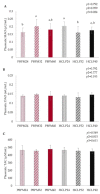Effects of Diets Based on Hydrolyzed Chicken Liver and Different Protein Concentrations on the Formation and Deamination of Biogenic Amines and Total Antioxidant Capacity of Dogs
- PMID: 37627369
- PMCID: PMC10451964
- DOI: 10.3390/ani13162578
Effects of Diets Based on Hydrolyzed Chicken Liver and Different Protein Concentrations on the Formation and Deamination of Biogenic Amines and Total Antioxidant Capacity of Dogs
Abstract
Biogenic amines are synthesized through the bacterial decarboxylation of amino acids, commonly found in high levels in animal by-product meals due to spoilage. Furthermore, biogenic amines and other metabolites can be produced by the fermentation of proteins in the hindgut according to the protein source and concentration of crude protein (CP) in the diet. Thus, this study aimed to evaluate two protein sources (poultry by-product meal (PBPM) and hydrolyzed chicken liver powder (HCLP)) and three CP concentrations (24, 32, and 40%) and their effects on the consumption and fecal excretion of biogenic amines, plasma monoamine oxidase (MAO) and diamine oxidase (DAO) activities, and total antioxidant capacity (TAC) of healthy adult dogs after 30 days of feeding the experimental diets. Twelve dogs were randomly distributed into six treatments (n = 6/treatment): PBPM24 (PBPM with 24% CP); PBPM32 (PBPM with 32% CP); PBPM40 (PBPM with 40% CP); HCLP24 (HCLP with 24% CP); HCLP32 (HCLP with 32% CP); HCLP40 (HCLP with 40% CP). The PBPM and PBPM-based diets had higher concentrations of putrescine, cadaverine, tyramine, histamine, agmatine, and total biogenic amines. In contrast, HCLP and HCLP-based diets contained higher concentrations of spermidine, phenylethylamine, and spermine. The PBPM and PBPM-diets had higher biogenic amine index (BAI) indicating lower quality due to the high content of putrescine, cadaverine and tyramine. Dogs fed diets with PBPM and higher protein concentrations consumed more putrescine, cadaverine, tyramine, agmatine, and total amines (p < 0.0001), while dogs fed with HCLP consumed more spermidine, phenylethylamine, and spermine (p < 0.0001). Fecal excretion of phenylethylamine was greater in dogs fed HCLP32 and HCLP40 diets (p = 0.045). Dogs fed with HCLP tended to excrete more spermidine and tryptamine via feces, while higher protein concentrations tended to increase fecal excretion of cadaverine (p < 0.10). Plasma MAO activity was higher in dogs fed HCLP24 and PBPM32 diets (p = 0.024). The plasma activities of DAO and TAC were not different between diets (p > 0.05). Although we did not evaluate the intestinal activities of MAO and DAO, our results suggest that healthy adult dogs have an efficient deamination process on the gut epithelium.
Keywords: biogenic amines; diamine oxidase; dog diets; hydrolyzed chicken liver powder; monoamine oxidase; poultry by-product meal.
Conflict of interest statement
Marcelino Bortolo and Fábio Ritter Marx are employees of Kemin Industries. The funders had no role in the design of the study, in the collection, analyses, or interpretation of data. The other authors declare no conflicts of interest.
Figures

Similar articles
-
Effects of hydrolyzed chicken liver on digestibility, fecal and urinary characteristics, and fecal metabolites of adult dogs.J Anim Sci. 2023 Jan 3;101:skad366. doi: 10.1093/jas/skad366. J Anim Sci. 2023. PMID: 37930712 Free PMC article.
-
Hydrolyzed chicken liver used as single source of animal protein in diet and its effect on cytokines, immunoglobulins, and fecal microbiota profile of adult dogs.PLoS One. 2022 Jul 22;17(7):e0271932. doi: 10.1371/journal.pone.0271932. eCollection 2022. PLoS One. 2022. PMID: 35867776 Free PMC article.
-
The effect of age and carbohydrate and protein sources on digestibility, fecal microbiota, fermentation products, fecal IgA, and immunological blood parameters in dogs.J Anim Sci. 2017 Jun;95(6):2452-2466. doi: 10.2527/jas.2016.1302. J Anim Sci. 2017. PMID: 28727033
-
Biogenic Amines in Plant-Origin Foods: Are They Frequently Underestimated in Low-Histamine Diets?Foods. 2018 Dec 14;7(12):205. doi: 10.3390/foods7120205. Foods. 2018. PMID: 30558197 Free PMC article. Review.
-
Control of biogenic amines in food--existing and emerging approaches.J Food Sci. 2010 Sep;75(7):R139-50. doi: 10.1111/j.1750-3841.2010.01774.x. J Food Sci. 2010. PMID: 21535566 Free PMC article. Review.
Cited by
-
Bioactive peptides extracted from hydrolyzed animal byproducts for dogs and cats.Anim Front. 2024 Jun 20;14(3):38-45. doi: 10.1093/af/vfae012. eCollection 2024 Jun. Anim Front. 2024. PMID: 38910953 Free PMC article. No abstract available.
References
-
- Feddern V., Mazzuco H., Fonseca F.N., De Lima G.J.M.M. A review on biogenic amines in food and feed: Toxicological aspects, impact on health and control measures. Anim. Prod. Sci. 2019;59:608–618. doi: 10.1071/AN18076. - DOI
-
- Martínez-Alvarez O., Chamorro S., Brenes A. Protein hydrolysates from animal processing by-products as a source of bioactive molecules with interest in animal feeding: A review. Food Res. Int. 2015;73:204–212. doi: 10.1016/j.foodres.2015.04.005. - DOI
LinkOut - more resources
Full Text Sources
Miscellaneous

